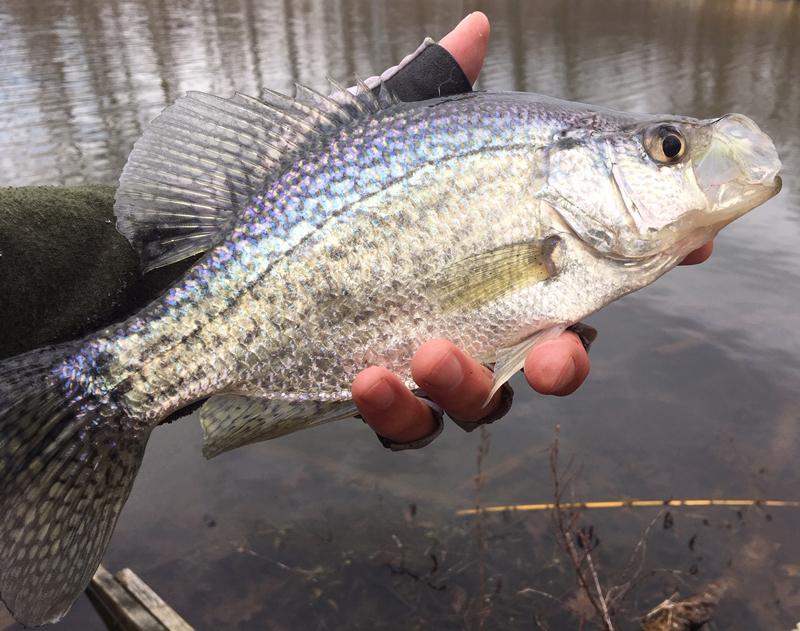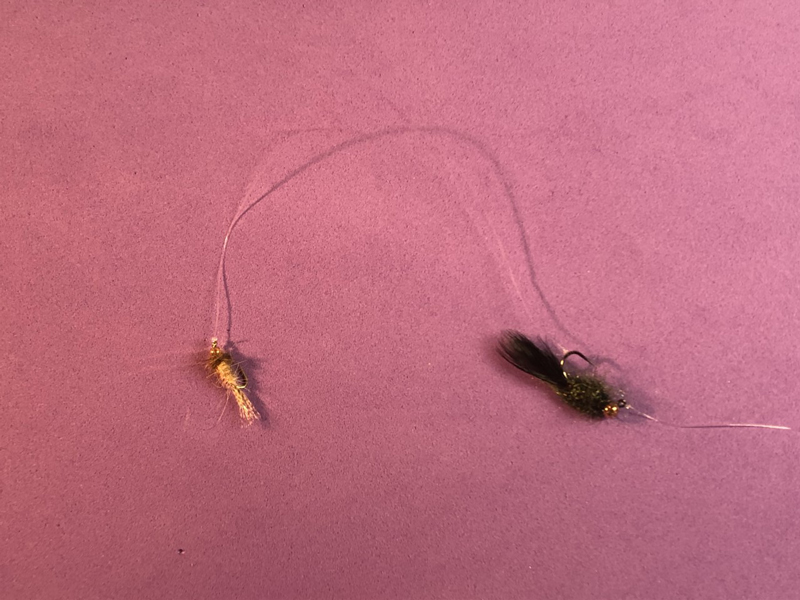Something I love about Chesapeake Bay fishing is the relatively mild winters compared to my home state of Pennsylvania. As much as I love fishing, freezing in an ice shanty and all the work and special equipment involved with ice fishing is not for me. Once Rocktober finishes and the bites on the Bay start to dwindle in November, I turn my attention to freshwater fishing. And among the many fish biting in the wintertime, crappie are a terrific species for both action and a delicious fish fry. Moreover, what I almost never see are anglers fly casting for slabs. To me that’s a missed opportunity, because a fly rod can do almost all of the same techniques used by conventional tackle but often times better.

Watching a bobber sit there with a minnow under it can get boring quickly, unless the action is red hot. Fishing with tiny jigs is fun and works very well, but it is a balance between a jig that is too heavy and gets hung up in the brush piles, or too light and is tough to cast far. Fly fishing takes care of all of those issues. The angler controls the action, which means not having to rely on a minnow that is tired and cold to look lively and delicious to predators. You also never have to worry about your fly falling off the hook, so you can get back to the action in a fraction of a second after catching a fish or losing one. Even better, the weight of the fly can be far lighter than even a 1/32-ounce jig, and the fly line will cast as far as you like. To top it all off, I find using short ultralight rods gives me the best fight with spinning gear, but it can be difficult to detect the subtle bites from cold fish. A nine-foot fly rod has a tip that can detect the most unnoticeable of strikes and even on ones you do not feel, requires far less effort to set the hook.
It does not take much to get set up to fly fish for crappie. If you don’t own a fly rod, you do not need to spend hundreds of dollars on an outfit; a cheap setup from a big box store will suit you just fine. The standard for fly outfits is a nine-foot, five-weight rod. Using a four-weight can give you a better fight, but sometimes it can be tough to cast on windy days.
You will need an eight- to nine-foot 3X or 4X leader, and a spool of tippet to match (crappie are not leader shy, so mono will work and you only need to go to 5X or 6X if the fish are super-finicky). I personally like to tie a small swivel around seven feet into the leader, then tie the tippet to that. It helps with line twist and is easier than doing leader-to-tippet knots.
Next is the fly setup. There are a number of different ways you can do this. If you think about it logically, those marabou crappie jigs you see in bait shops are basically the same as a Woolly Bugger. I recommend a size eight to 12 in white, black, and chartreuse, depending on what the fish are biting. A brass bead-head might be good, but tungsten sinks too fast in still water. It is not a bad idea to keep a size six around in case there is a bigger crappie lurking in the school. This is probably the most versatile way to fly fish for crappies, because you have one fly that you can fish any way you choose. Letting it sink and a slow lift creates a suspended action that often triggers bites. Short, sharp strips on the fly line will articulate the fly and give it more bounce. Then, if the fish seem to be very lively, you can give the rod tip a slight pop after a pause that fishes the fly like a jig. With the fly rod, you have control over every aspect of how the fly is presented.
On a sunny day, I would go with the smaller Woolly Bugger or small streamer, tie a foot of tippet to the bend of the hook, and tie a size 14 to 16 Flash Back Hare’s Ear nymph. A slow lift mimics insects hatching and triggers feeding frenzies. You can catch fish after fish as the day warms up.

There are a couple more setups for the more advanced fly angler. The first is similar to a drop-shot rig. I like to use a heavier jig fly that is around 1/16 of an ounce that acts like the weight, and a fly that either flutters, like a rabbit streamer, or has a sheen, like a Zug Bug, a foot or so up the line. You might snag the bottom fly here and there, but you also have the chance at hooking two fish at once. This rig can be fished on the leader setup I described earlier, or vertically without using fly line. To do that, wind on a length of line close to the depth you want to fish. Tie your barrel swivel to the end of that line and add four feet of tippet, tying your top fly a foot or so from the heavy fly with a loop knot.
Lastly, for the angler who likes to fish deep, I recommend a sink-tip line with two to three feet of leader and something that floats. This is where an English Booby streamer comes in handy (where you can fish them) or even a foam beetle. This method gets the fly down deep, but keeps it from snagging on anything on the bottom.

You don’t need to change up where and when you target crappie with a fly rod, but if the conditions aren’t too windy, you can catch more fish in the same amount of time using these techniques.
-By Peter Turcik